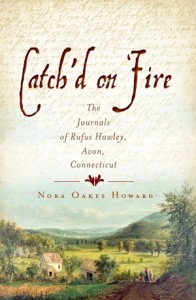.
The Author Nora Howard Introduces Book About the Rev. Rufus Hawley
Hawley Society members from near and far visit Avon to hear about ‘Catch’d on Fire.’

At West Avon Congregational Church, Avon historian and author Nora Oakes Howard presented her newly published book on the life of Rev. Rufus Hawley (1741-1826) to the best possible audience, members of the Hawley Society.
The Hawleys, who came from all over the country and beyond, decided to have the society’s 81st annual meeting in the Farmington Valley after learning about Howard’s book, which is based on journals written by Rev. Hawley over the course of 50 years.
“We didn’t have to worry about who our speaker would be; we had Nora,” said Michael Hawley of Chicago, president of the Hawley Society.
Of the 32 society members who gathered in Avon that Saturday, the closest came from nearby Collinsville and the farthest, from England. Other locales represented ranged from New York and Pennsylvania to Arizona and Wyoming and Canada. One man was from Ontario, Canada.
Society members also visited the First Church of Christ in Farmington and the nearby Memento Mori cemetery, where the ancestor of many of them, Capt. Joseph Hawley, is buried.
“Capt. Hawley moved from Stratford to Farmington,” said Trudy Hawley of Minnesota, who organized the annual meeting.
The captain, who served 12 terms in the Connecticut General Assembly, was grandfather to Rufus Hawley, born in Farmington to Timothy and Rachel Forward Hawley. Rufus’ family later moved to Turkey Hills, now known as East Granby.
After being educated at Hatfield Academy in Massachusetts and Yale College, Rufus Hawley was ordained in 1769 and was called to serve as pastor of Farmington’s Parish of Northington, short for North Farmington, which later became known as Avon. He was the second pastor of the parish, succeeding Rev. Ebenezer Booge.
The church meetinghouse, located on property that is now at the end of Reverknolls off of Waterville Road (Rte. 10), burned to the ground in December, 1817. That tragedy is the basis of Howard’s book title, “Catch’d on Fire.” Asked why she chose the title, Howard said,
“I wanted to use words that [Hawley] actually used [in the journals] and something that would attract attention. Also, fire was a tragic theme of his life, both physically and spiritually.”
The book took a great deal of time to research and write – 10 years – but Howard was determined to tell the story of a man who was an integral part of Avon’s past. She thanked those who helped along the way, including staff members oft the Avon Free Public Library, where the Hawley collection is now kept, and Terri Wilson, president of the Avon Historical Society. Howard also credited members of West Avon Congregational Church including Wick Mallory, who helped her transcribe Hawley’s 33 journals, which were 4 inches wide and written in diminutive cursive.
“It took seven months and ran into 1,000 typed pages,” she said.
Other records such as church minutes were used in her research, but the main source was the collection of papers and photos that Bob and Gladys August found in the Hawley house at 281 Old Farms Road when they bought it in 1951.
.jpg)
Rev Rufus Hawley Home
Built by Rev. Hawley in 1798, the house remained in the Hawley family for five generations, and the woman who sold it to the Augusts gave them the collection.
“The Augusts worked on the collection, transcribing some of the letters, and after they moved to a smaller home, they donated everything to the library,” Howard said.
In reading Hawley’s journals, she learned that before the meetinghouse was destroyed by fire, its location on the east side of the Farmington River became increasingly unpopular because “powerful” parishioners from the now West Avon area had to cross the river to go to church.
The discord in his parish forced Hawley to resign in December, 1917. Less than a month later, the meetinghouse was destroyed and its cause determined as arson.
One theory was that the fire was set by some of the unhappy parishioners; another was that it was caused by mischievous youngsters; and a third was that Hawley was the arsonist.
When it came time to decide where to build a new meetinghouse, the majority of voters wanted it to be west of the river, which led to construction of what is now called West Avon Congregational Church.
Those who lived on the east side of the river wanted a closer parish, and built what is now called Avon Congregational Church in 1819. Parishioners who went to worship there were called “breakaway renegades,” Howard said.
Fire struck part of the Hawley home more than a century later in 1950, when Grace Birney lived there.
“It broke her heart and she sold the house outside the family,” Howard said.
The fact that Birney left Hawley’s collection with the Augusts, who cared for it, is remarkable, she said.
“The preservation of [Rev. Hawley’s] records is close to a miracle,” Howard said.
After their meeting, some society members visited the Hawley house, now owned by Mark Borenstein and his wife, Courtney Robinson. The couple bought the home in 1998 from the Augusts, who taught them about the Hawleys.
“We’re so happy to be carrying on what the Augusts have done in preserving the house and the Hawley legacy,” Robinson said.
Source: Barbara Thomas, Farmington Patch, October 17, 2011
var _gaq = _gaq || []; _gaq.push(['_setAccount', 'UA-8174059-2']); _gaq.push(['_trackPageview']);
(function() { var ga = document.createElement('script'); ga.type = 'text/javascript'; ga.async = true; ga.src = ('https:' == document.location.protocol ? 'https://ssl' : 'http://www') + '.google-analytics.com/ga.js'; var s = document.getElementsByTagName('script')[0]; s.parentNode.insertBefore(ga, s); })();


